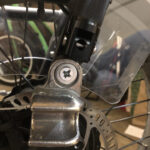Navigating the world of bicycles can be overwhelming, especially when faced with technical jargon and unfamiliar components. Understanding the different parts of your bike is not just about sounding knowledgeable; it’s crucial for effective communication during maintenance, repairs, or when seeking advice. This guide breaks down the anatomy of a bicycle, explaining each part in detail to help beginners become more familiar with their rides.
Bike Frame Parts
The frame is the foundational structure of any bicycle, providing the backbone to which all other parts are attached. Historically crafted from steel, modern bike frames are often constructed from aluminum alloy due to its balance of strength and weight. High-performance bikes may utilize carbon fiber or titanium for enhanced lightness and stiffness. A bike frame needs to be robust enough to withstand riding stresses, yet light enough for efficient pedaling and handling.
A frameset refers to the combination of the frame and the fork, working in concert as the core structural elements of the bike.
The diamond frame is the most recognizable and common frame design. It’s characterized by two triangles formed by six main tubes, offering a strong and efficient structure.
 Diagram illustrating the anatomy of a diamond bicycle frame highlighting top tube, head tube, down tube, seat tube, seat stays, and chain stays
Diagram illustrating the anatomy of a diamond bicycle frame highlighting top tube, head tube, down tube, seat tube, seat stays, and chain stays
Top Tube
Often referred to as the cross-bar, the top tube is the horizontal or slightly angled tube that you typically step over when getting on or off a traditional diamond frame bike. While usually parallel to the ground, some bike designs, particularly those aimed at comfort or accessibility, feature significantly sloping or absent top tubes for easier mounting and dismounting.
Head Tube
Located at the front of the frame, the head tube is a short, cylindrical section that serves as the crucial connection point between the handlebars and the fork of the front wheel. It houses the headset, a bearing assembly that allows smooth steering by enabling the fork to rotate freely within the head tube in response to handlebar input.
Down Tube
The down tube is a prominent, usually thick tube extending from the head tube, just beneath the handlebars, down towards the pedal area or bottom bracket. It’s a key structural member and often the location for mounting water bottle cages and displaying the bicycle brand’s logo.
Seat Tube
Oriented vertically, the seat tube extends from the bottom bracket area upwards to just below the saddle. It’s designed to receive the seat post, which slides into the seat tube to allow for saddle height adjustments. Raising or lowering the seat post within the seat tube customizes the bike fit for different rider leg lengths.
Seat Stays
These are typically thinner tubes that branch from the upper part of the seat tube, near the saddle, and extend downwards and rearwards to connect with the rear wheel hub area. Each seat stay terminates at a rear dropout, a slotted fitting that secures the rear wheel axle to the frame.
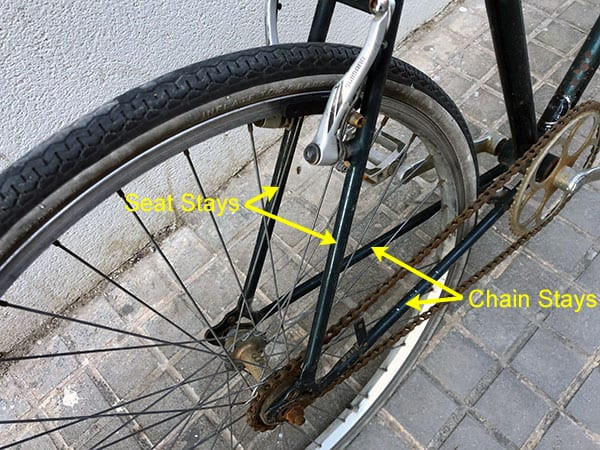 Image showcasing seat stays and chain stays on a bicycle frame, emphasizing their position relative to the rear wheel
Image showcasing seat stays and chain stays on a bicycle frame, emphasizing their position relative to the rear wheel
Chain Stays
Running parallel to the ground, the chain stays are another pair of slender tubes. They originate from the bottom bracket area, near the pedals, and extend horizontally back to connect with the rear wheel hub area. Positioned alongside the bike chain, they are aptly named chain stays and play a role in frame stiffness and power transfer.
Front Bike Components
This section describes the parts located at the front of the bicycle, crucial for steering, control, and braking.
Fork
The fork is the component that directly holds and connects the front wheel to the bike frame, specifically to the head tube. The fork blades are the two arms extending downwards from the head tube, embracing the front wheel from either side. Internally, the steerer tube is a hidden extension at the top of the fork that passes through the head tube and interfaces with the headset mechanism.
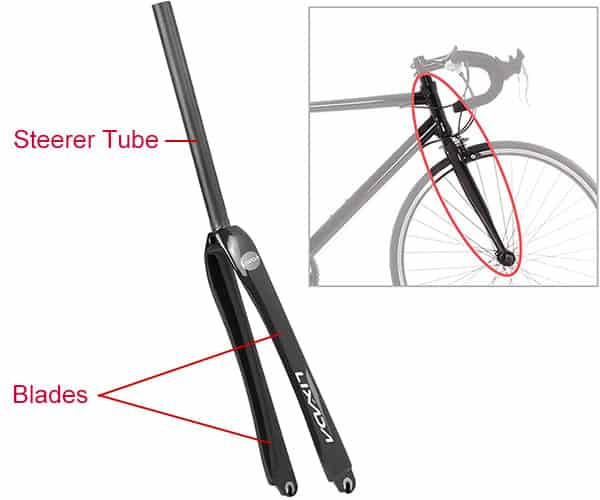 Diagram illustrating bicycle fork anatomy including steerer tube and fork blades, with Lixada Fork as visual example
Diagram illustrating bicycle fork anatomy including steerer tube and fork blades, with Lixada Fork as visual example
Headset
The headset is a critical assembly of bearings and races located within the head tube. It facilitates smooth and controlled rotation of the fork’s steerer tube, which in turn allows the handlebars to effectively steer the front wheel. A properly functioning headset is essential for responsive and safe bike handling.
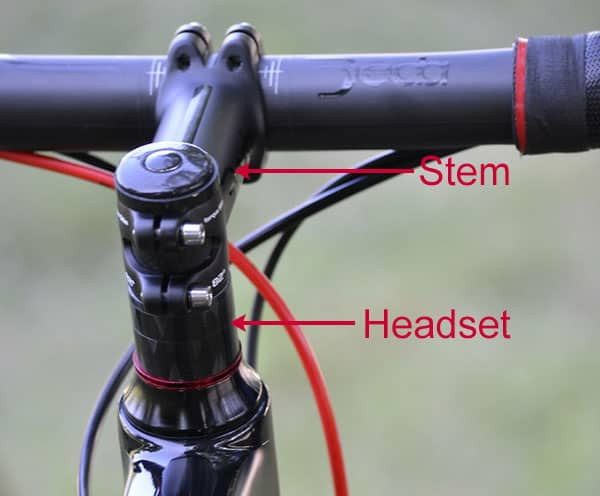 Image of a bicycle headset and stem assembly, highlighting their connection and function in steering
Image of a bicycle headset and stem assembly, highlighting their connection and function in steering
Stem
The stem acts as the bridge connecting the fork’s steerer tube to the handlebars. It projects forward from the top of the head tube and clamps onto the steerer tube at one end, while the handlebars are securely mounted to the other end. Stem length and angle influence rider position and reach.
Handlebars
Handlebars are the primary control interface for steering the bicycle. Attached to the stem, they come in a variety of shapes and styles tailored to different types of bikes and riding preferences. Flat handlebars are common on mountain bikes, hybrid bikes, and urban bikes, offering an upright riding position and responsive control. Drop handlebars, characterized by their curved shape, are typically found on road bikes, providing multiple hand positions for varied terrain and aerodynamic efficiency.
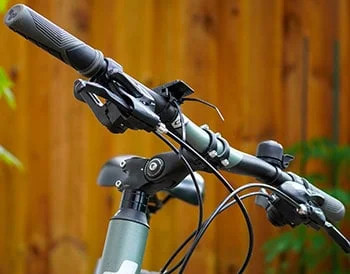 Image showcasing straight handlebars commonly found on mountain or hybrid bikes
Image showcasing straight handlebars commonly found on mountain or hybrid bikes
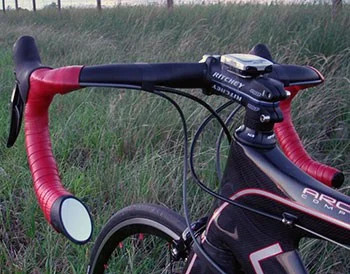 Image showcasing drop handlebars typical of road bikes, emphasizing their curved aerodynamic design
Image showcasing drop handlebars typical of road bikes, emphasizing their curved aerodynamic design
Brake Levers
Brake levers are handlebar-mounted controls that, when squeezed, activate the bicycle’s braking system to slow down or stop. In some integrated designs, brake levers are combined with gear shifters, forming brake/shift levers or “brifters,” especially common on road bikes with integrated shifting. Brake cables extend from the levers down to the brake calipers at the wheels, transmitting the braking force.
Brakes (Rim vs Disc)
Bicycles primarily utilize two types of braking systems: rim brakes and disc brakes. Rim brakes, also known as caliper brakes, operate by applying friction to the wheel rim. They are widely used due to their lightweight design, affordability, ease of maintenance, and reliable stopping power in dry conditions. However, their performance can diminish in wet or muddy conditions as water and debris on the rim reduce friction.
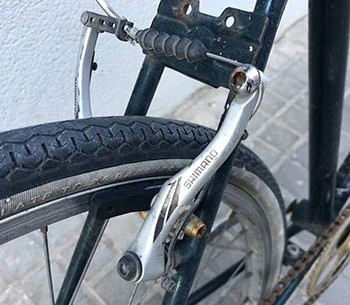 Image of rim brakes, specifically cantilever brakes, mounted on a bicycle wheel rim
Image of rim brakes, specifically cantilever brakes, mounted on a bicycle wheel rim
Disc brakes employ a rotor or disc attached to the wheel hub. Calipers squeeze brake pads against this rotor to generate stopping force. Disc brakes offer superior performance in wet conditions and are generally more robust than rim brakes. Initially prevalent in mountain biking for their demanding terrain capabilities, disc brakes are increasingly adopted across various bicycle types, including road and hybrid bikes, for their consistent and powerful braking.
 Image of a disc brake system on a bicycle, highlighting the rotor and caliper mechanism
Image of a disc brake system on a bicycle, highlighting the rotor and caliper mechanism
Bike Wheel Components
Wheels are fundamental to a bicycle’s mobility. A standard bicycle has two wheels, collectively referred to as a wheelset. Tricycles feature three wheels for added stability. Each wheel is an assembly of several components working together.
Hub
The hub is the central component of a bike wheel, located at its axis. It’s comprised of three main parts: the hub shell, bearings, and axle. The hub shell is the outer casing to which the spokes are attached. The axle is a rod passing through the hub’s center, protruding on both sides to attach to the frame dropouts. Bearings are housed between the axle and the hub shell, enabling the shell and wheel to rotate smoothly around the stationary axle.
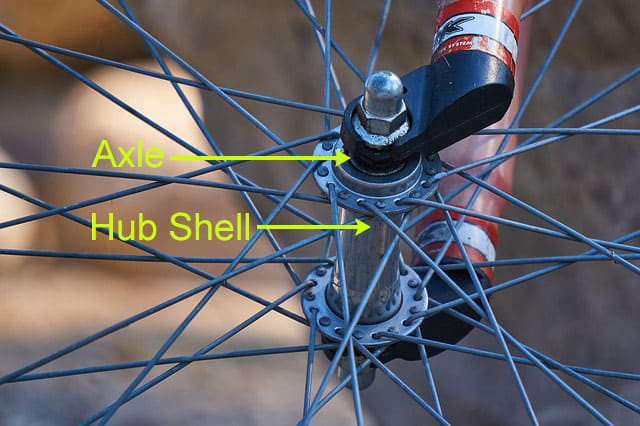 Diagram illustrating the components of a bicycle wheel hub, showing axle and hub shell in detail
Diagram illustrating the components of a bicycle wheel hub, showing axle and hub shell in detail
Rim
The rim is the outer circular hoop of the wheel, forming its circumference. Historically made of steel, modern rims are primarily constructed from aluminum alloy for reduced weight and improved performance. Rims designed for use with rim brakes feature a smooth sidewall surface that provides a consistent braking surface for the brake pads to grip.
 Diagram of a complete bicycle wheel, labeling rim, spokes, hub, and tire components
Diagram of a complete bicycle wheel, labeling rim, spokes, hub, and tire components
Spokes
Spokes are the wire components that connect the rim to the hub. They are meticulously arranged and tensioned to distribute load evenly across the wheel, creating a strong, stable, and lightweight structure capable of supporting rider weight and pedaling forces. At the rim end, nipples are specialized nuts that thread onto the spokes and allow for spoke tension adjustments, crucial for wheel trueness.
Tire
The tire is the rubber component mounted onto the wheel rim, providing the contact point between the bicycle and the riding surface. Bike tires are typically constructed from layers of rubber-impregnated fabric, with a thicker outer layer featuring tread patterns for grip and traction. Most bike tires are clincher tires, designed to be used with an air-filled inner tube inside, which provides cushioning and suspension.
Valve (Schrader vs Presta)
The valve is a fitting on the inner tube that protrudes through a hole in the rim, allowing air to be added or removed from the tube. Two primary types of valves are used on bicycles: Schrader valves and Presta valves. Schrader valves are also commonly found on car and motorcycle tires, known for their robust and simple design. Presta valves, often found on higher-performance bicycles, are narrower and typically feature a valve core that needs to be unlocked before inflation.
 Image of a Schrader tire valve, commonly used on bikes and cars, showing its wider and robust design
Image of a Schrader tire valve, commonly used on bikes and cars, showing its wider and robust design
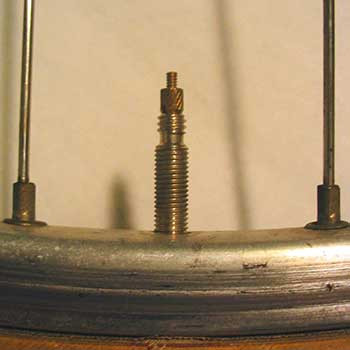 Image of a Presta tire valve, often found on performance bikes, highlighting its narrower design and locking tip
Image of a Presta tire valve, often found on performance bikes, highlighting its narrower design and locking tip
Rear Bike Components
The rear section of the bike houses components responsible for propulsion, gear changing, and further braking.
Crankset / Chainset
The crankset, also referred to as the chainset, is the assembly that the rider’s legs drive to propel the bicycle. It consists of chainrings, the toothed gears that the chain engages with, and crank arms, to which the pedals are attached. Chainrings act as the front gears on bikes equipped with multiple gears. Single-speed bikes have only one chainring. Geared bikes can have up to three chainrings to provide a wider range of gear ratios. The crankset is connected to the frame via the bottom bracket, to the rear wheel through the chain, and directly to the rider via the pedals.
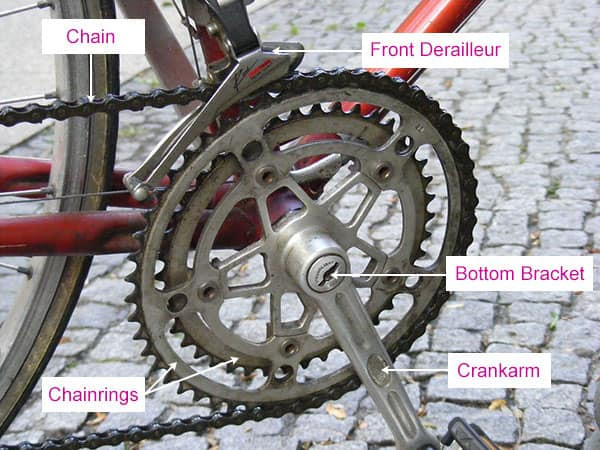 Diagram of a bike crankset and associated components, highlighting chainrings, crank arms, and pedals
Diagram of a bike crankset and associated components, highlighting chainrings, crank arms, and pedals
Pedals
Pedals are the interface between the rider’s feet and the bicycle’s drivetrain. Pushing down on the pedals transfers power through the crankset and chain to propel the bike forward. There are two main categories of pedals: flat/platform pedals and clip-in pedals. Flat pedals provide a simple platform for the rider to rest their feet on, suitable for casual riding and various types of footwear. Clip-in pedals, also known as clipless pedals, require specialized cycling shoes with cleats that mechanically engage with the pedal, providing a more secure and efficient connection for performance cycling.
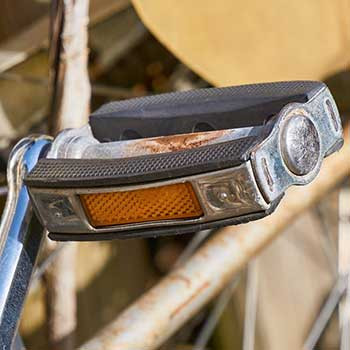 Image of a flat or platform pedal, illustrating its simple design for general use
Image of a flat or platform pedal, illustrating its simple design for general use
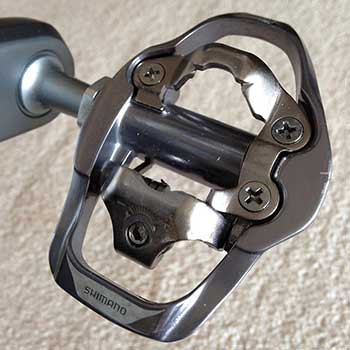 Image of a clip-in pedal, showcasing its mechanism for engaging with cycling shoe cleats for enhanced pedaling efficiency
Image of a clip-in pedal, showcasing its mechanism for engaging with cycling shoe cleats for enhanced pedaling efficiency
Bottom Bracket
The bottom bracket is the bearing assembly that allows the crank arms and crankset to rotate smoothly. It includes a spindle, which the crankset attaches to, and bearings that facilitate the spindle’s rotation within the bottom bracket shell, a threaded or press-fit cylinder at the base of the bike frame.
Chain
The bike chain is the crucial component that transmits power from the crankset to the rear wheel’s cassette. It loops around the chainrings at the front and the sprockets of the cassette at the rear, running along the chain stays. Maintaining a clean and lubricated chain is essential for efficient and smooth drivetrain operation.
Front Derailleur
The front derailleur is a mechanism used on bikes with multiple front chainrings. Its function is to shift the chain laterally from one chainring to another as the rider changes gears, providing different gear ratios for varying terrain and riding conditions. Bikes with only a single front chainring do not have a front derailleur.
Cassette / Cogset
The cassette, or cogset, is a cluster of sprockets of varying sizes mounted on the rear wheel hub. These sprockets are the rear gears of the bicycle. The combination of different sized sprockets in the cassette, along with the front chainrings (if present), provides a range of gear ratios for efficient pedaling at different speeds and inclines. Single-speed bikes have only one cog instead of a cassette.
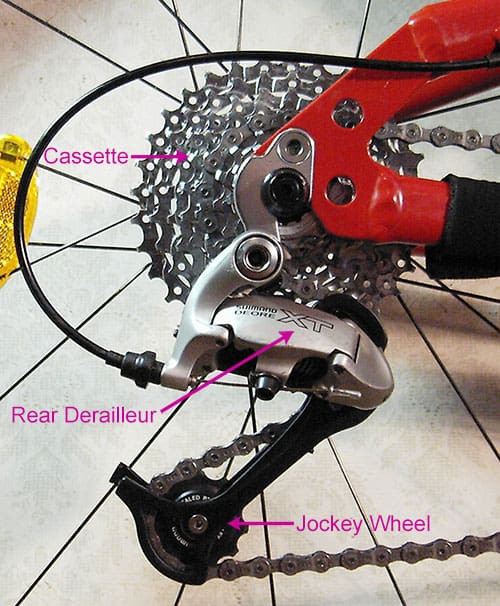 Diagram illustrating rear bike gears, showing cassette, rear derailleur, and jockey wheel components
Diagram illustrating rear bike gears, showing cassette, rear derailleur, and jockey wheel components
Rear Derailleur
The rear derailleur is a mechanism that shifts the chain across the different sprockets of the cassette when the rider changes gears. It works in conjunction with the jockey wheel or derailleur pulleys to guide the chain smoothly and precisely onto the desired sprocket. Rear derailleurs are essential components of geared bicycles.
Jockey Wheel
The jockey wheel, or derailleur pulley, is part of the rear derailleur mechanism. It plays a role in maintaining chain tension and ensuring smooth chain movement as gears are changed. While primarily associated with geared bikes, a jockey wheel may also be used as a chain tensioner on some single-speed bikes, especially those with vertical dropouts.
Bike Seat Components
The seat area components are crucial for rider comfort and adjustability.
Saddle
The saddle, also known as the seat, is where the rider’s weight is primarily supported. Saddles come in a wide variety of shapes, sizes, and padding levels to accommodate different rider anatomies and riding styles. All saddles feature saddle rails on their underside, which are used to attach the saddle to the seat post via a saddle clamp.
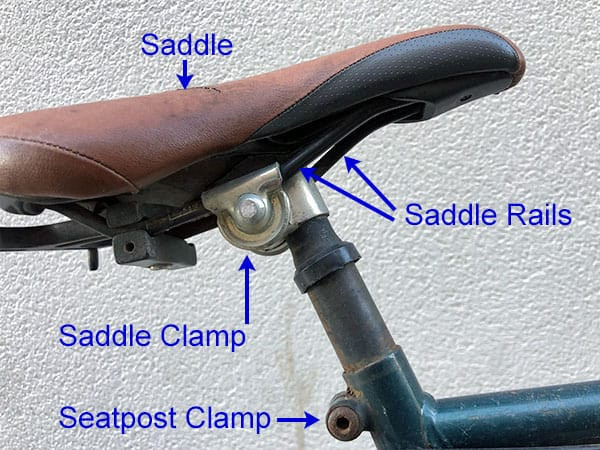 Diagram showcasing bike saddle parts, highlighting saddle rails and general saddle construction
Diagram showcasing bike saddle parts, highlighting saddle rails and general saddle construction
Seat Post
The seat post is a cylindrical component that inserts into the seat tube of the frame and connects to the saddle. Its primary function is to allow for vertical adjustment of the saddle height to suit the rider’s leg length and preferred riding position. A seat post clamp, positioned at the top of the seat tube, secures the seat post at the desired height by tightening around the seat tube and seat post.

